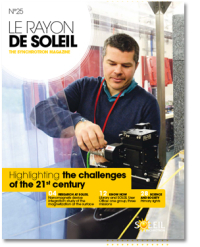| 2015 December. 2015 being the International Year of Light, as declared by the UN, this was the perfect occasion for organizing many events where SOLEIL took center stage, for example, the lecture by Sylvain Ravy, “How light became a wave” in June or the Science Festival in October(..) there are even more beamlines this year to host user communities, making 27 in total with the addition of ROCK and NANOSCOPIUM. As for the HERMES beamline, its XPEEM (X-ray Photoemission Electron Microscopy) station opened in the summer and its latest instrument, the Scanning Transmission X-ray Microscope (STXM) has recently welcomed its first users... |
Contents
Research at SOLEIL
 DEIMOS - Nanomagnets device integration: study of the magnetization at the surface
DEIMOS - Nanomagnets device integration: study of the magnetization at the surface
At the nanometer scale, properties of matter start to diverge from those of the bulk, and size dependent effects come into play. Magnetism at the nanoscale is a fast growing area that attracts intense activity in both fundamental and applied research. As the scaling down process continues to advance, particle characterization becomes significantly more challenging or inadequate...
TEMPO - Near ambient pressure photoemission and environmental science
Using an original setup designed on the TEMPO beamline by scientists from Laboratory of Physical Chemistry- Matter and Radiation (UPMC, Paris), it becomes possible to carry out x-ray photemission spectroscopy measurements at pressures that can reach 20 mbars, far from ultra-high vacuum conditions. This bridges the pressure gap with “real-life” conditions, and allows applications in environmental sciences, for instance.
Know-how
The High Pressure Laboratory Diamonds and know-how available to scientists
Open to users for the last four years, the High Pressure Laboratory (HPL) provides, as its name suggests, the equipment and expertise necessary for conducting studies under extreme pressure conditions. The laboratory specialized in high pressure cells.
Portrait: Marie LABAT, Researcher in the Diagnostics Group
With a PhD in theoretical nuclear physics from the University of Tokyo, Ryutaro Nagaoka very quickly decided to specialize in accelerator physics. A change of direction that reflected his desire to work in a scientific field that applied more directly to society.
Spotlight on Library and SOLEIL User Office
When the storage ring operates in top-up injection mode, electrons can accumulate in parasitic bunches, deteriorating the purity of the electron beam filling patterns and hence the quality of time structure of the photon beams provided to the beamlines. But did you know that it is possible to clean out a bunch of electrons?
FOCUS ON
Highlighting the challenges of the 21st century
Medecine - a nanoflash-light to activate drugs in solid tumors DISCO-METROLOGIE (p16)
Light has been used in medicine for decades, until now. Photodynamic therapy (PDT) relies on the use of substances which become toxic for their immediate environment when subjected to visible light.
ENERGY - A SOCIETY TURNING TO HYDROGEN ROCK-SAMBA (p17)
One of the great issues facing our society is to find alternatives to fossil fuels, the reserves of which are dwindling day by day.
Environment – Radionuclides and sea water MARS (p18)
What happens to natural radionuclides or those resulting from nuclear activity in the environment, particularly in sea water?
Legion fever and dengue: X rays against bacteria and virus PROXIMA2 (p20)
This year, beamline PROXIMA2 has contributed to major findings concerning two pathogens: the bacteria called Legionella pneumophila and virus DENV, respectively responsible for the Legion fever
Innovations
The professional integration of young graduates in industry
Beyond the (initial or research) training of young people working temporarily within its research groups, SOLEIL is keen to ensure their employability in three sectors: directly with SOLEIL, in public research institutions or in industry...
SOLEIL Science and Society
Primary lights
Scientific awareness is one of SOLEIL’s missions and for over 10 years it has attempted to share scientific and technical knowledge with the general public. As 2015 was the Year of Light, this was a perfect excuse to develop a new project for 8 to 11-year-old pupils and their teachers.
